| Origami Heaven A paperfolding
paradise
The website of
writer and paperfolding designer David Mitchell
x
|
| |
| Even Distribution Designs |
| |
Even
distribution designs are a special class of modular
origami design characterised by the completely even
distribution of the paper across the exterior surface of
the design. There are a surprising number of them in the
origami repertoire.
|
| |
| Two
layers deep |
| |
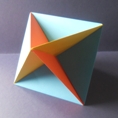 |
|
Name: Robert Neale's
Octahedron, Skeletal Octahedron or
Nolid Octahedron Modules / Paper
shape / Folding geometry: 6 modules from squares
using standard folding geometry.
Designer /
Date: Robert Neale, mid 1960s. Many other
paperfolders have independently originated this
design , including Kunihiko Kasahara, also in the
mid 1960's, slightly later than Robert Neale but
on the other side of the world, and Joe Power, in
Hawaii, sometime in the early to mid 1970's.
Diagrams:
On-line diagrams are available on the Modular Designs page of this site.
|
|
| |
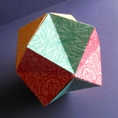 |
|
Name: The Harlequin Star aka
Blue Balloon / Epsilon Star Modules / Paper
shape / Folding geometry: 6 modules from squares
using standard folding geometry.
Designer /
Date: Kenneth Kawamura, early to mid 1970s.
Robert Neale also independently discovered this
design at an early date. I do not know who has
creative priority.
Diagrams:
On-line diagrams are available on the Modular Designs page of this site.
|
|
| |
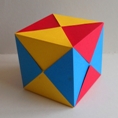 |
|
Name: The Harlequin Cube Modules / Paper
shape / Folding geometry: 6 modules from squares
using standard folding geometry.
Designer /
Date: Kenneth Kawamura in the early 1970's.
Diagrams:
On-line diagrams are available on the Modular Designs page of this site.
|
|
| |
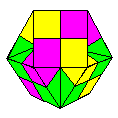 |
|
Name: The Windmill
Base Cuboctahedron - so named because the
modules are obtained by partially opening out the
folds of a standard windmill base. Modules / Paper
shape / Folding geometry: 6 modules from squares
using standard folding geometry.
Designer /
Date: I discovered this design in 1989. It has
also been discovered by Michael Naughton. I do
not know which of us has creaative priority.
Diagrams:
Not yet available.
|
|
| |
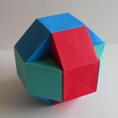 |
|
Name: Rhombicuboctahedron
(6-part) / The
Multi-Ball Modules / Paper
shape / Folding geometry: 6 modules from squares
using standard folding geometry. There are
versions from 4x4 and 3x3 grids.
Designer /
Date: The 3x3 grid version was discovered by
Kenneth Kawamura in the early to mid 1970s.
Robert E Neale independently discovered the same
design, and quite possibly also the 4x4 version,
but cannot now recall at what date the discovery
was made. Michael Naughton and I both also
discovered both versions for ourselves in 1991
and 1988 respectively. Michael realised that the
proportions of the designs could be varied so
that the flat faces become oblongs rather than
squares. He calls this variable version the
Multi-Ball.
Diagrams:
On-line diagrams are available on the Modular Designs page of this site.
|
|
| |
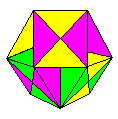 |
|
Name: The Butterfly
Ball Modules / Paper shape / Folding
geometry: 12 very simple modules from squares
using standard folding geometry.
Designer /
Date: Kenneth Kawamura, early to mid 1970s.
Diagrams:
Diagrams were published in Kenneth Kawamura's
booklet 'Meditations on a Waterbomb' in 1977.
|
|
| |
 |
|
Name: The Gamma
Antiprism is a delicate, but strong and
stable, design. Tom Hull has pointed out that
paper of four different colours need to be used
if it is to be assembled without any of the
colours sharing an edge - an unusual property for
a modular design. Modules / Paper shape / Folding
geometry: 8 very simple modules from squares
using standard folding geometry.
Designer /
Date: David Mitchell, 1999.
Diagrams:
In Building with Butterflies - David Mitchell -
Water Trade - ISBN 978-0-9534774-7-0.
|
|
| |
 |
|
Name: Binary Modules / Paper
shape / Folding geometry: 2 modules from squares
using various folding geometries.
Designer /
Date: David Mitchell, 1988.
Diagrams:
On-line diagrams are available on the Modular Designs page of this site.
|
|
| |
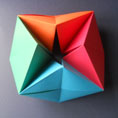 |
|
Name: Rotating
Ring of 8 Rhombic Tetrahedra Modules / Paper
shape / Folding geometry: 4 modules from silver
rectangles.
Designer /
Date: David Mitchell, 1995.
Diagrams:
In Mathematical Origami - David Mitchell -
Tarquin 1997 - ISBN 189961818X.
|
|
| |
| Four
layers deep |
| |
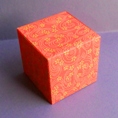 |
|
Name: The
Paul Jackson Cube. Modules / Paper
shape / Folding geometry: 6 modules from squares
using standard folding geometry.
Designer /
Date: Paul Jackson, early 1970's.
Diagrams:
On-line diagrams can be found on the Modular Designs page of this site..
|
|
| |
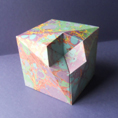 |
|
Name: Metamorphosis
- arrived at by applying the
metamorphosis 1 distortion to one complete corner
of the Paul Jackson Cube. Modules / Paper
shape / Folding geometry: 6 modules from squares
using standard folding geometry.
Designer /
Date: David Mitchell, 1990. In its final clean
form the design is my own but it owes much to the
earlier work of Iris Walker, Ricky Wong and Wayne
Brown.
Diagrams:
In Building with Butterflies - David Mitchell -
Water Trade - ISBN 978-0-9534774-7-0.
|
|
| |
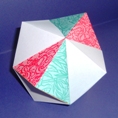 |
|
Name: Bi-colour Harlequin
Stars Modules / Paper shape / Folding
geometry: 6 modules from squares using standard
folding geometry.
Designer /
Date: David Mitchell, 1989.
Diagrams:
On-line diagrams are available on the Modular Designs page of this site.
|
|
| |
| Eight
layers deep |
| |
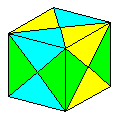 |
|
Name: The Sonobe Cube Modules / Paper
shape / Folding geometry: 6 modules from squares
using standard folding geometry. Cubes made from
larger numbers of modules are also possible.
Designer /
Date: Mitsonobu Sonobe, c1965.
Diagrams:
On-line diagrams are available on the Modular Designs page of this site.
|
|
| |
| Nine
layers deep |
| |
 |
|
Name: The Simplex
Cube Modules / Paper shape / Folding
geometry: 24 L-shaped Simplex modules from
squares using standard folding geometry. Cubes
made from larger numbers of modules are also
possible.
Designer /
Date: David Mitchell, 1989.
Diagrams:
On-line diagrams are available on the Modular Designs page of this site.
|
|
| |
| |













